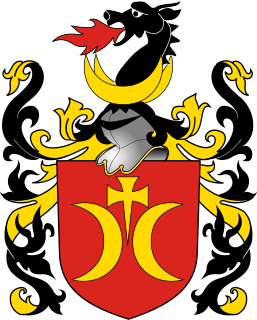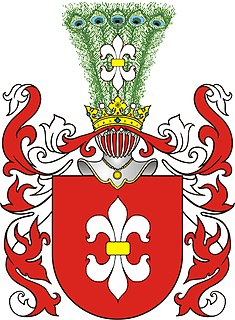This article lists the Polish titled families.
This list is not complete because in the 19th century Poland was a divided kingdom, between the Russian, the Austrian and the German Empires.
Contents

This article lists the Polish titled families.
This list is not complete because in the 19th century Poland was a divided kingdom, between the Russian, the Austrian and the German Empires.


The szlachta were the noble estate of the realm in the Kingdom of Poland, the Grand Duchy of Lithuania, and the Polish–Lithuanian Commonwealth who, as a class, had the dominating position in the state, exercising extensive political rights and power. Szlachta as a class differed significantly from the feudal nobility of Western Europe. The estate was officially abolished in 1921 by the March Constitution.

Ciołek is a Polish coat of arms, one of the oldest in medieval Poland. It was used by many szlachta (noble) families under the late Piast dynasty, under the Polish–Lithuanian Commonwealth, during the Partitions of Poland, and in the 20th century. The variant names "Siolek" and "Cialek" arose from miscommunication among early-20th-century Polish immigrants to the United States.

Łabędź is a Polish coat of arms. It was used by many noble families known as szlachta in Polish in medieval Poland and later under the Polish–Lithuanian Commonwealth, branches of the original medieval Duninowie Grand Duke family (Łabędzie) family as well as families connected with the Clan by adoption.

Janina is a Polish nobility clan coat-of-arms. Borne by several noble families descended in the-male line from the medieval lords of Janina or legally adopted into the clan upon ennoblement.

Polish heraldry refers to the study of coats of arms in the lands of historical Poland. It focuses on specifically Polish traits of heraldry. The term is also used to refer to the Polish heraldic system, as opposed to systems used elsewhere, notably in Western Europe. As such, it is an integral part of the history of the szlachta, the nobility of Poland.

Radwan is a Polish knights' clan (ród) and a Polish coat of arms used by the szlachta.

Sas or Szász is a Central European coat of arms. It was borne since the medieval period by several Transylvanian-Saxon Hungarian, Ruthenian, Ukrainian, and Polish-Lithuanian noble families. The house was once a mighty princely and ducal house with origins in Saxony, Transylvania, Hungary and Ruthenia.

Ostoja is a Polish coat of arms that probably originated from Sarmatian Tamga and refer to Royal Sarmatians using Draco standard. Following the end of the Roman Empire, in the Middle Ages it was used by Ostoja family in Lesser Poland and later also in Kujavia, Mazowsze and Greater Poland. It is a coat of arms of noble families that fought in the same military unit using battle cry Hostoja or Ostoja, and that applied their ancient heritage on the Coat of Arms, forming a Clan of knights. Later, when the Clan expanded their territory to Pomerania, Prussia, Slovakia, Hungary and Romania they also adopted a few noble families of Ruthenian origin that in 14-15th century settled down in Lithuania, Belarus and Ukraine, finally turning into the Clan of Ostoja. As different lines of the clan formed surnames after their properties and adding the adoptions, Ostoja was also recognized as CoA of several families that was not necessary connected to the original Clan, forming Heraldic clan.

Kur is a Polish coat of arms. It was used by several noble families forming a Clan of Kur in the times of the Kingdom of Poland and the Polish–Lithuanian Commonwealth. It is noted during the reign of the Jagiellon dynasty and illustrated with its original name in the work of Bartosz Paprocki "Herby Rycerstwa Polskiego" in 1584. Furthermore, it is published in the work of Szymon Okolski in 1641. and several other publications

Przyszowa is a village in southern Poland, in the Limanowa County, within the province of Lesser Poland. It lies approximately 61 km (38 mi) south-east of the regional capital Kraków. The village has 2,470 inhabitants.
Danielewicz is a patronymic surname, meaning descendants of Daniel or Danilo. Several Danielewicz families were members of Polish–Lithuanian Commonwealth nobility and their descendants continue to the present.

Clan Ostoja was a powerful group of knights and lords in late-medieval Europe. The clan encompassed families in the Polish–Lithuanian Commonwealth, Hungary and Upper Hungary, Transylvania, and Prussia. The clan crest is the Ostoja coat of arms, and the battle cry is Ostoja ("Mainstay") or Hostoja ("Prevail"). The clan, of Alan origin, adopted the Royal-Sarmatian tamga draco (dragon) emblem.

This noble family traces its origins to the territorial County of Gniezno in the Voivodeship of Greater Poland. There in the administrative district of Gmina Witkowo is the village of Chłądowo. In 1692 Chłądowo was owned by the Chłędowski family. This branch of the family belongs to the Gryf Clan.

A heraldic clan, in Poland, comprised all the noble (szlachta) bearers of the same coat of arms. The members of a heraldic clan were not necessarily linked by consanguinity. The concept of heraldic clan was unique to Polish heraldry.

Małgorzata Dąbrowska is a Polish historian, Byzantinist, dean of the History Department at the University of Łódź. She specializes in Byzantine studies, specifically the topics of Byzantium and the West in 13th-15th centuries, mixed marriages in the Imperial family of the Palaiologoi, rivalry between the Palaiologoi and Kantakouzenoi families, the Empire of Trebizond and the Pontus, the relationship between Kingdom of Poland and Byzantium, as well as Polish contemporary history.

The princely houses of Poland and Lithuania differed from other princely houses in Europe. Most importantly, Polish nobility (szlachta) could not be granted nobility titles by the Polish kings in the Polish-Lithuanian Commonwealth. Therefore, the title of prince either dated to the times before the Union of Lublin, which created the Commonwealth in 1569, or was granted to some nobles by foreign kings. Due to the longstanding history of common statehood, some noble families often described as "Polish" actually originated in Grand Duchy of Lithuania and are of Lithuanian or Ruthenian descent. Some houses are more correctly described as being of Polish-Lithuanian Commonwealth.

The House of Żeleński is a Polish princely family and one of the most influential noble families in pre-World War II Poland. The Żeleński family's coat of arms is the Ciołek coat of arms, which is one of the oldest in medieval Poland. The Żeleński family reached notable power under the late Piast dynasty, under the Polish–Lithuanian Commonwealth, during the Partitions of Poland, and in the 20th and 21st centuries.